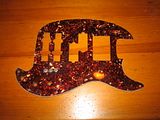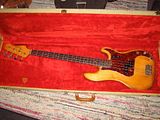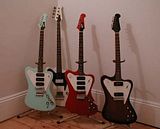This is a late 60's Gibson EB-3 bass - structurally very similar to a 68/69 EB-0 I recently finished and sold on Ebay, but thats been through some trials and mods over the years.
The mods are minor and reversible - notably, the bridge position mini-humbucker was replaced with a Rickenbacker "toaster" pickup from a '67 Rick 4005 bass - as were all the electronics and knobs. This was actually one of the primary motivations for me to acquire this bass - I coincidentally have a mid-60s Rick 4005 bass in pieces - missing the electronics and one pickup - lost pieces eventually recirculate to their rightful places - perhaps I have stumbled upon a very material expression of the eastern concept of karma - "guitarma ??"
The main "trial" this bass has been through - besides having its cherry finish stripped - is that like many Gibsons, it suffered a headstock break. Apparently this was repaired by laminating a 1/8" thick piece of mahogany on the back of the headstock. Also, the Gibson logo was removed and replaced with an approximation in mother of pearl and there was an extra hole to fill in the front of the body for the added Rickenbacker "blend" knob.
The bass also had a replacement metal (steel?) pickguard and control panel cover and a chromed finger rest.
On the plus side - the bass had the original neck humbucker, bridge, mute assembly, tuners and hard shell case - and outside of two finger wear spots on the front of the bass and the extra control hole, the body was in excellent condition. I have the correct Pat # baby humbucker for the bridge position, repro knobs and will make a new pickguard, backplate and thumbrest.
The two parts I dont have are the brass control cavity shield and the 4-position Variatone switch. But I'll keep looking or simply install an SG-style toggle.
The first step after disassembly was to take down the headstock to the proper thickness on a belt sander - taking care not to make it uneven or TOO thin. I left the last little bit of the laminated piece on and used a sanding block to even everything out. Not surprisingly, there was no serial number remaining. I also had to recarve the neck to headstock transition - using my 65 EB-0 as a guide - not too tricky.
The headstock repair seemed very solid - no worries about it pulling apart - the laminated mahogany was an overkill type repair. And once everything was sanded down, there was nothing that a good solid color refin wouldn't cover up ! And I am very fond of Pelham Blue.
I plugged the control with a mahogany plug and then used some nitro based scratch filler on the deeper of the two wear marks and the control plug. This view is BEFORE sanding.
The body and neck were completely sanded and then grain filler was slopped on - and allowed to partly dry before I scrubbed off the excess. After drying overnight, I sanded the entire bass down again - using a sanding block, a random orbital sander and plain old sandpaper. I then sealed the filler with a good heavy coat of clear nitro sanding sealer - and the grain really "popped" after this treatment. I almost felt bad about covering that gorgeous wood up with blue paint ...
This is what a piece of mahogany with the grain properly filled should look like - notice that there is no filler on the surface of the wood - only in the grain, so that once a clear coat is applied, the wood has a mirror finish that still emphasizes the grain of the mahogany.
I used my Pelham Blue Melodymaker as a guide on matching the color - since the MM is heavily yellowed, I had to look for places it was well worn to get an idea of the original color - which is a surprisingly bright metallic blue, that of course appears green after 40 years of the top coat yellowing. I'll try to post a few closeups of the MM later - but meanwhile, here is the EB-3 with the first few color coats on.
(added Oct. 24th, 10:30 am)
OK, here are a few pictures of the EB-3 compared to the original Pelham Blue finish, beat-to-hell Melodymaker guitar. Notice how the different light radically changes the appearance of the Pelham Blue - the pictures above were taken under my shop neon lights - the ones below were taken under low-power halogens.
The first picture is a close-up of one area on the MM where the top coat has worn off and left some of the original finish exposed - compare this to the picture above and you will see how close the two metallic blues are.
This guitar was played to death - lots of mojo.
Then here is a pic of the EB-3 by itself (some parts just placed) and side by side with the MM. I'd have to do a lot of yellowing to match that color !!
( Updated Oct. 26th, 11:30 PM)
OK - so I touched up the Pelham Blue - looked pretty much perfect, and then began applying a yellowed/ambered topcoat to start getting the EB-3 towards the proper aged green look. A tricky proposition to get a nice even color - but I made a good start - Sunday I'll try a lighter tinted coat and try to even out the back and get the front a little bit greener - and do the back of the headstock too!
A pic of the front of the bass - and then a picture of the neck with yellowing and headstock without yellowing to show the contrast.













Very nice work, and really nice touch to green it out. Are you going to relic it a bit - wear it down - or just green it up? Throw some of this up at the Last Bass.
ReplyDeleteThe Gibson EB series was and is one of the worst , wimpy basses ever made. Gibson basses (except for possibly the Thunderbirds) are absolute weak shit. Nobody of any note whatsoever plays Gibson basses because they are so awful.
ReplyDeleteMike Watt plays and EB
DeleteJack Bruce played an EB3 your comments are weak shit lol
DeleteI don't really agree with you on this, though I will admit that going back to my '70 P-bass is always a relief after playing pretty much ANYTHING else. The biggest problem I have with the EB-0s and EB-3s is the neck pickup, which is poorly positioned and just too powerful in my opinion. But the EB-3 gets around this with the additional bridge pickup. What I do like about them is the light weight and more guitar like feel of the 30 inch scale models.
ReplyDeleteAs for players of note, both Jack Bruce and Mike Watt have made some pretty impressive use of the EB-3 - and did like what Felix Pappalardi did with his EB-1, though I do believe he "cheated" by adding a p-bass pickup!
Short-scale basses in general can be fun - the lower string tension makes bending the strings easier for "lead bass" playing.
Hello,
ReplyDeleteI'm willing to know if the bridge of this bass is mounted with studs or with screws directly into the wood. Please reply to syst3mjay@gmail.com
Many thanks !
Jay
Phil Lesh from the Grateful Dead played a 63 Gibson EB-3 for a lot of the early shows and dead recordings.
ReplyDeleteThis is likely a great playing and sounding bass, I owned a(likely pre 1968) EB-3 (regret to have sold). I (too) didn't take Gibson basses seriously, but once I picked it up and played it, I had to give them credit. This is a great bass and works well playing in various bands. (Oh and the Jackson Five can be seen with an EB-3 as well ;-)). I would like Gibson or Epiphone to make a tribute Mike Wat model (like Fender), because I don't really like the original positions of the pick ups that much either (especially if you don't have a bridge pick up).
ReplyDeleteHi, good post. I have been thinking about this issue, so thanks for sharing. I will definitely be coming back to your blog.
ReplyDelete